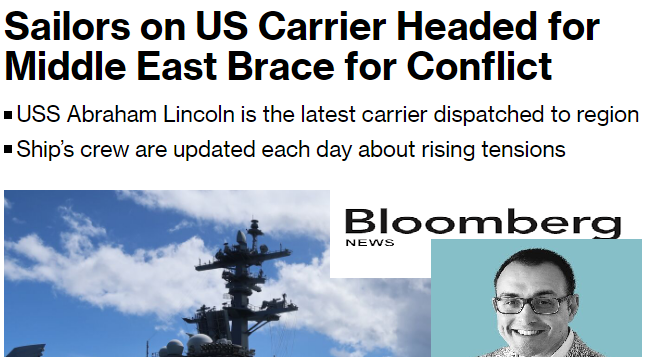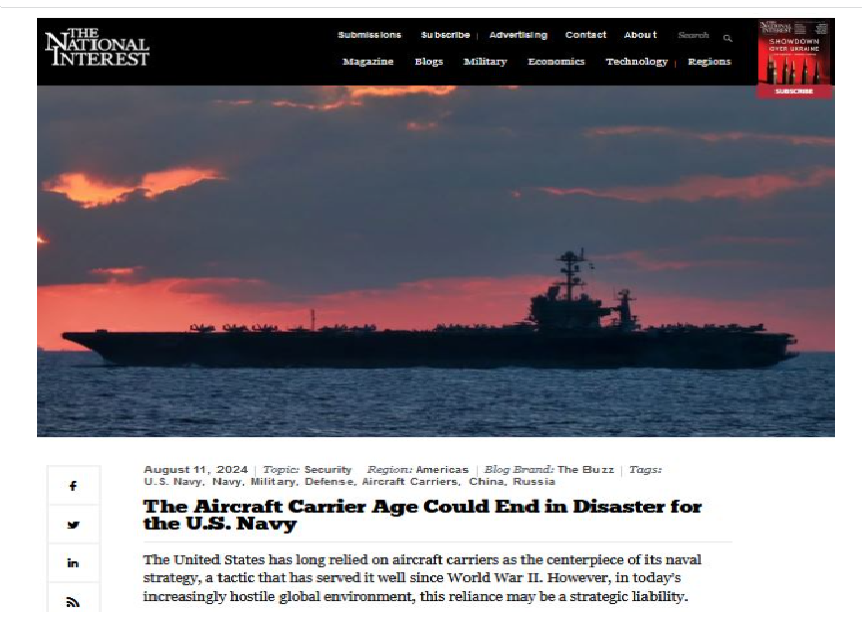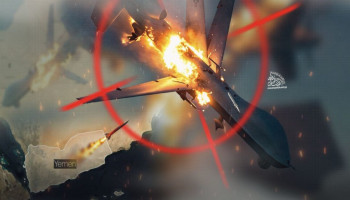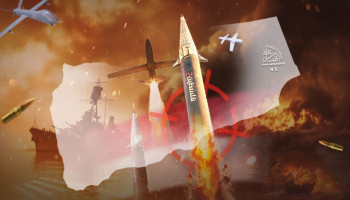The American enemy continues to rely on its naval fleet to protect the Zionist entity, despite bitter experiences with Yemeni weapons, which have surpassed them in technology and accuracy. As Washington sends new naval units to the region, U.S. officials and the Washington press are admitting the failure of all weapons against Yemen, stating that American reinforcements will only lead to further moral and material losses. The experiments have proven the inability of air defenses to neutralize Yemeni threats; even laser weapons are ineffective, as the mission is fraught with risks. The replacement of battleships and aircraft carriers is a sign of failure, reinforced by the American admission that the production of warships is at its worst in 25 years, a situation exacerbated by Yemen’s ability to update and develop its military technologies.
Despite these realities, Washington persists in sending its naval fleet after admitting its failures, revealing the extent of Zionist lobby influence in American decision-making. On Sunday, the U.S. Pentagon announced that Defense Secretary Lloyd Austin renewed, in a phone call with the Zionist entity's “Minister of Security,” Yoav Gallant, the United States' commitment to taking every possible step to defend "Israel," announcing "the enhancement of U.S. forces and their capabilities across the Middle East in light of escalating regional tensions."
To reinforce this commitment, according to the Pentagon statement, Austin ordered the U.S. aircraft carrier group, "Abraham Lincoln," equipped with F-35C fighters, to hasten its transition to the Central Command area of responsibility, to add to the capabilities provided by the aircraft carrier group, "Theodore Roosevelt." He also ordered the guided-missile submarine "Georgia" to head to the Central Command area.
The "Lincoln" Carrier Faces Risks
Following the American announcement, Bloomberg reported that the crew of the U.S. aircraft carrier "Abraham Lincoln" is trying to mentally prepare for a "long engagement" in the Middle East. Sailors and pilots aboard the carrier are preparing mentally for complex naval operations that could draw the United States into a broader regional conflict. Many analysts believe that these military operations achieve little deterrence and expose American forces to great risk without achieving clear strategic objectives.
The agency noted that amid rising tensions in the Middle East, the U.S. Navy faces significant psychological challenges, with the crew of the "Abraham Lincoln" carrier trying to cope with the idea of a "long engagement" in the region, despite significant doubts about the effectiveness of their presence there.
Questions arise about the value of sending the U.S. aircraft carrier, as the previous carrier, "Roosevelt," did not even approach the operational area during its entire deployment, raising doubts about the effectiveness of these military moves. The international relations expert, Jackson, described the deployment of the aircraft carrier as a risky and ineffective move in deterring adversaries, noting that American military interventions in the Middle East have not yielded any tangible benefits. This strengthens the feeling that the U.S. Navy finds itself in a weak and vulnerable position in a region filled with threats and complexities.

The Replacement of Naval Units as a Sign of Weakness
Days ago, the American magazine "National Interest" reported that the U.S. Navy's need to replace the aircraft carriers (Eisenhower) and (Roosevelt) in succession reveals the state of depletion the United States is facing in its naval capabilities. It highlights the lack of sufficient warships to confront all threats, noting that the extension of carrier deployments, as happened with (Eisenhower), leads to expensive maintenance costs.
The magazine reported that the U.S. aircraft carrier (USS Abraham Lincoln) is moving from the Pacific Ocean to the Red Sea, where it will replace its sister carrier (USS Theodore Roosevelt), which arrived in the Fifth Fleet's area of operations a few weeks ago, replacing the carrier (USS Dwight D. Eisenhower).
The report added that the rotation of aircraft carriers highlights the current state of depletion in the United States, as the carrier (Eisenhower) had its deployment extended twice, leading to the decision to send the (Theodore Roosevelt) carrier to the region to prevent a third extension.
It continued that the deployment of the (Roosevelt) carrier in the Middle East exposed a weakness in the U.S. Navy, which is the lack of a sufficient number of warships and aircraft carriers. The extension of the (Eisenhower) carrier's deployment several times has resulted in severe pressure.
The report emphasized that the extent of the depletion of the U.S. Navy's carrier fleet became clear only when the Navy was forced to deal with multiple threats simultaneously. Even as the (Eisenhower) carrier returns home from the Red Sea, the (Roosevelt) carrier will remain in the region for a few more weeks, while the (Lincoln) carrier will serve as a temporary solution until the (USS Harry S. Truman) carrier arrives in the area.
The report added that the U.S. Navy is now forced to play an increasingly complex game of musical chairs with its active aircraft carriers. Despite managing eleven aircraft carriers, it is rare to have more than five or six deployed at sea at any one time.
It is noteworthy that the (Theodore Roosevelt) carrier arrived on July 12 in the Fifth Fleet's area of operations in the Red Sea, following the departure of the (Eisenhower) carrier and its group.
This arrival followed the departure of the (Eisenhower) carrier strike group from the Red Sea on June 22, after seven months of deployment in the region. The (Eisenhower) carrier's withdrawal came after multiple attacks by Yemeni armed forces using missiles and drones.
In early August, the United States announced that there were no American warships along the Red Sea coast, following the continued Yemeni blockade on American, Israeli, and British navigation.
Pentagon Deputy Spokesperson Sabrina Singh acknowledged the absence of any U.S. warships in the Red Sea for the first time since October 2023. According to specialized ship-tracking websites, data showed a complete absence of American and British ships, as well as Israeli ships or those linked to the Zionist entity, along the Red Sea, Arabian Sea, and Gulf of Aden due to military operations carried out by Yemeni armed forces in support of the Palestinian people.

Costly Defense and Cheap Defeat
American acknowledgments of Yemen's military strength continue, confirming that advanced Western technologies have failed to confront the Yemeni front supporting Gaza. The "Jacobin" magazine reported that advanced Western military technologies have clearly failed in asymmetrical warfare, and the confrontation with the Yemeni army in the Red Sea has demonstrated this.
In a report titled "The Incompetence of Masters of War," the magazine stated that "giant Western defense companies boast about advanced technology, but their sophisticated systems often fail in asymmetrical warfare, from faulty missile defense systems to expensive aircraft carriers. The only thing that consistently works is the profit machine."
The report mentioned that "when the Yemeni political and military movement (Ansar Allah) began launching drones and missiles at commercial ships in the Bab al-Mandab Strait in solidarity with Gaza, instead of addressing the declared goals of the Houthis, the West responded with armed force."
It added that "after eight months of the fiercest naval combat experienced since World War II, the unintended truth of that hollow bluster is more apparent than its authors could ever have intended."
The report pointed out that "in June, the (USS Dwight D. Eisenhower) aircraft carrier, a prominent example of American hard power, withdrew from the Red Sea waters adjacent to Yemen. Conflicting reports emerged about whether the Yemeni army had succeeded in hitting and damaging the ship or whether the ship had simply exhausted its interceptor missiles in response to the barrage of drones launched by the Yemeni army."
Regardless of the exact cause, the situation demonstrated that deploying the strongest navy in history—and possibly losing its strongest ships—was significantly more costly, in purely financial terms, than the cost its adversaries might incur in the event of an attack.
The report considered that "the spread of cheap and cost-effective weapons among the West's asymmetric adversaries has significantly weakened the power of conventional weapons systems. The rational course of action would be to accept this and redirect these hundreds of billions of dollars wasted on social programs and infrastructure, as almost anything would be more defensible than the current situation."
U.S. Struggles to Modernize Its Naval Fleet
The naval battle has revealed the American inability to innovate or develop its naval weapons, relying instead on rotating its naval units, which has made it easier for the Yemeni army to target most of the American naval vessels. In this regard, The Associated Press reported that the U.S. Navy faces challenges in building low-cost warships capable of intercepting “Houthi” missiles in the Red Sea. The production of warships in the United States is reportedly at its worst in 25 years, with the Navy relying on a workforce that averages 25 years old, many of whom previously manufactured parts for garbage trucks.
The Associated Press report highlighted that "labor shortages are among the countless challenges that have led to a backlog in ship production and maintenance at a time when the Navy faces increasing global threats. Alongside changing defense priorities, last-minute design changes, and cost overruns, the United States has fallen behind China in the number of ships available, and the gap is widening."
Eric Labs, a veteran analyst at the Congressional Budget Office, stated, “Warship building is in a terrible state, the worst in a quarter-century, and I don't see an easy way out of it. I am very concerned.”
“Marinette Marine is under contract to build six guided-missile frigates — the Navy's newest surface warships — with options to build four more. But it only has enough workers to produce one frigate a year,” Labs pointed out.
The report explained that “one of the main problems facing the industry is the struggle to hire and retain workers to do the difficult work of building new ships. As older workers retire, they take decades of experience with them.”
The report also pointed out that “much of the blame for the current challenges facing shipbuilding in the United States lies with the Navy itself, which frequently changes requirements, requests upgrades, and modifies designs after shipbuilders have already begun construction. This results in cost overruns and technological challenges, as well as the early retirement of some of the Navy's lightly armored coastal combat ships, which were prone to breakdowns."

Even Laser Weapons Cannot Defeat Yemen’s Arsenal
After admitting its total failure to counter Yemen's weapons, the United States has begun searching for unconventional weapons to overcome Yemen’s arsenal. The American magazine "National Interest" reported on Sunday that laser weapons, which are being promoted as an alternative to the expensive defensive missiles used by the Navy to counter Yemeni drones and missiles in the Red Sea, will not actually be an effective or even viable replacement in the near future. These weapons require high electrical power that cannot be provided aboard warships, and their range is very limited. Even if they are introduced in the future, they will be part of existing defense layers, not a replacement for them.
The magazine published a report stating, “The Houthis have succeeded in targeting U.S. Navy warships in the Red Sea and the Gulf of Aden with missiles and drones. Can the U.S. Navy use lasers to defend itself?”
It explained that “laser weapons, which are being promoted as cost-effective alternatives, are still in the development stage but face significant challenges, including high power requirements and limited range.”
The report pointed out that “current laser systems, such as the Layered Laser Defense system developed by Lockheed Martin and the Dragonfire system from the United Kingdom, show promise but are not yet capable of replacing traditional missile defense systems.”
Washington Officially Admits Failure
After ten months of naval confrontations by the Yemeni Armed Forces in support of Gaza, the U.S. fleet commander has admitted failure to stop or limit Yemeni attacks. Vice Admiral George M. Wikoff, commander of the U.S. Fifth Fleet, acknowledged a qualitative shift in the military scene in Yemen, noting that the Yemeni Armed Forces have become capable of independently developing their offensive capabilities, moving beyond traditional reliance on Iranian support. He confirmed that these significant developments in the capabilities of the Yemeni Armed Forces have placed the U.S. Navy on the defensive, rendering it unable to impose effective deterrence against repeated attacks targeting Israeli maritime navigation in the Red Sea.
In an interview with the Center for Strategic and International Studies, Wikoff stated, "The problem in Yemen requires a global effort to solve. It is difficult to talk about deterring the 'Houthis,' as their operations are ongoing. Just a few nights ago, they attacked U.S. warships and targeted the Groton vessel. It’s laughable that this statement comes from someone who used to boast about U.S. military capabilities and that Washington would end the resistance in Yemen within days.”
Indeed, as the Yemeni Armed Forces stated at the beginning of the U.S. aggression on the country, Washington may have started the war, but stopping it would not be in Washington's hands; the decision would be made in Sana’a. Now, the commander of the U.S. Fifth Fleet confirms the warning from the Yemeni Armed Forces, acknowledging the inability to stop Yemeni attacks, saying: “We have succeeded in weakening the Houthis’ capabilities, but have we stopped them? No, that is their choice, and they can stop this any day they want.” Wikoff also admitted that U.S. forces are fighting the most sustained and intense war since World War II and that American sailors are battling in a grueling environment.
The Threat to Ships Continues
After ten months of Washington’s adoption of the mission to defend Israeli ships from Yemeni fire, it is now announcing the failure of its mission, which it had bet on achieving no matter the cost. Despite assembling several international coalitions for this purpose, the outcome has been admitted by the commander of the U.S. Fifth Fleet, who said: “The Houthis have succeeded in discouraging ships from passing through the Bab al-Mandeb Strait. Shipping companies are refusing to pass through Bab al-Mandeb before achieving greater stability in the region." He added, “We are trying to maintain our current position to allow other local and international arms to pressure the Houthis to stop what they are doing in the Red Sea.”
Fleet Commander Wikoff also noted that there is ongoing discussion about the possibility of the “Houthis” becoming future exporters of military technology, emphasizing that Washington needs a diplomatic solution so it won’t have to worry about trying to defend ships passing through the region. He stressed that what Washington truly relies on is the presence of rational actors in the region who behave reasonably.
Wikoff also touched on the fact that the “Houthis” are well-armed, and all it takes is for one of their weapons to hit an American or coalition warship, which would make the situation extremely difficult and dangerous. Therefore, the U.S. Navy needs defenses that are 100% effective.










